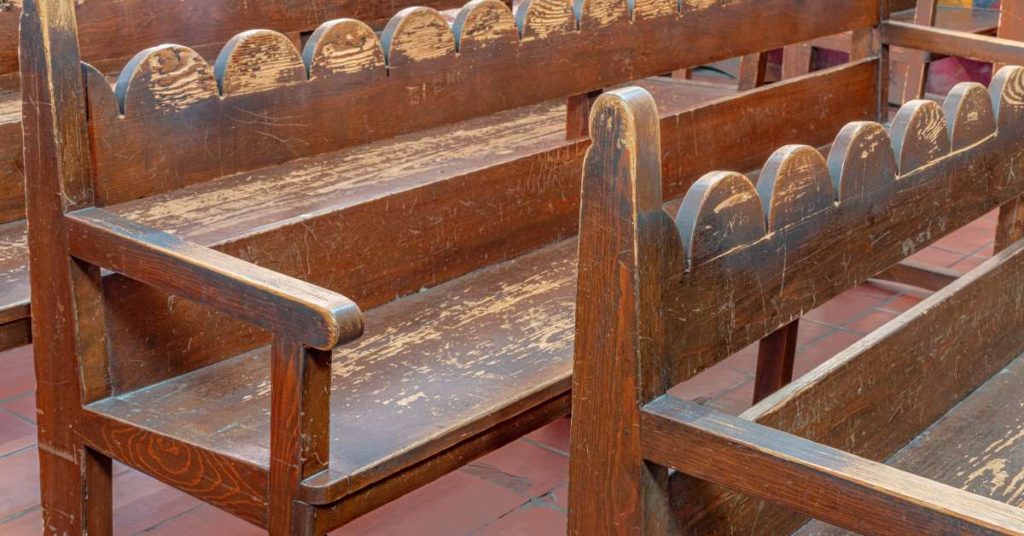Church pews are traditional elements of a church’s interior. Beautiful and functional pews are vital for maintaining the comfortable and welcoming atmosphere of your place of worship.
This ultimate guide aims to help church administrators and facility managers understand the church pew refinishing process, identify when work is necessary, and explore the benefits of professionally maintained seating.
The Importance of Maintaining Church Pews
Maintaining church pews is essential for several reasons. First, they contribute to the aesthetic appeal of the sanctuary. They also ensure the comfort of congregants during services, which can enhance their worship experience. Lastly, investing in pew maintenance can be cost-effective in the long run because it prevents the need for entire replacements.
Understanding when and how to refinish church pews is key to maintaining a comfortable and aesthetically pleasing service.

Signs That Your Church Pews Need Refinishing
Visible Wear and Tear
Visible wear and tear are apparent signs that your church pews need refinishing. Over time, the finish on pews can dull, crack, or chip, causing the wood to appear aged and neglected. Scratches, dents, and nicks detract from the beauty of the sanctuary. Addressing these visible signs of damage promptly ensures your house of worship remains inviting and comfortable while reflecting the care and reverence you hold for the space.
Fading and Discoloration
Over time, exposure to sunlight and regular use can cause pews to fade, lose their original color, and look old and neglected. When the wood appears washed out or inconsistent in color, it’s a strong indication that refinishing is necessary. Restoring the original color or even updating the finish can breathe new life into the seating, enhance their aesthetic appeal, and make the entire space feel more vibrant and welcoming.
Structural Issues
Over time, wooden pews can develop structural issues such as loose joints, cracked wood, or instability. These problems not only pose safety risks but also detract from the integrity of the seating. Refinishing involves thorough inspections and necessary repairs, keeping the pews sturdy and safe for use. Addressing structural issues during the refinishing process can extend the lifespan of the pews and provide a secure and reliable seating option for the congregation.
Unpleasant Odors
Another sign that your church pews may need refinishing is the presence of unpleasant odors. They can result from spills, moisture, and constant use over the years. Refinishing typically includes deep cleaning and sanitization to eliminate odors and create a fresher, more inviting environment for worship. By tackling this issue, you can improve the ambiance of your church, making it a more pleasant space for congregants.
Aged Appearance and Stains
Over time, church pews can develop an aged appearance that may detract from the church’s interior. Dark stains, worn patches, and uneven coloration are common indicators that the pews have aged. Years of use, exposure to elements, and accidental spills cause these issues. Refinishing your church pews can help to address these problems, rejuvenate their appearance, and ensure they add to the warmth of your worship space.
Refinishing Church Pews
Refinishing church pews can take some work. Here are a few tips to make sure your pews look and feel as good as the day they were made:
- The refinishing process begins with a thorough assessment of the pews’ condition. This includes identifying areas that need repair and determining the best approach for refinishing.
- Preparation involves cleaning the pews and sanding down the old finish to create a smooth surface for the new one.
- After prepping the pews, you can apply the new finish. This may involve staining the wood to achieve the desired color, followed by applying several coats of protective finish to enhance durability and shine.
- After the final coat dries, you can make final repairs or touch-ups. This step ensures the pews look as good as new and are ready to withstand years of use.
Choosing the Right Finish
You can choose from several finishes for church pews, including varnish, lacquer, and polyurethane. Each offers different levels of protection and shine, so choose one that meets your needs for durability and appearance.
Matching the Existing Décor
When selecting a finish, consider the interior of your church. The finish should complement the other woodwork and furniture in the sanctuary to maintain a cohesive look.
Eco-Friendly Options
If you’re looking to minimize your environmental impact, you can use eco-friendly finishes on the pews. These finishes contain natural ingredients with few harmful chemicals.

DIY vs. Professional Refinishing Services
Pros and Cons of DIY
Refinishing pews yourself can save money, but it requires significant time, effort, and expertise. Mistakes can be costly and time-consuming to fix, so weigh the pros and cons before DIYing.
Benefits of Professional Services
Professional church pew restoration services offer high-quality results. These experts have the tools and skills to handle the job, and their work often comes with a warranty. This can provide you with the peace of mind that the pros will do the refinishing correctly.
Finding a Reputable Service Provider
When choosing a professional service, look for companies with experience in refinishing church pews. Read reviews, ask for references, and get quotes from multiple providers to get the best value for your investment.
Budgeting and Cost Considerations
Factors Affecting Cost
Several factors can affect the cost of refinishing church pews, including the size and number of pews, the extent of the damage or wear, and the type of finish. Ask for detailed quotes to understand what is included in the price.
Cost-Effective Strategies
To keep costs down, consider refinishing pews in phases or focusing on the most worn areas first. Regular maintenance can extend the time between full refinishing, helping you save money in the long run.
Value of Investment
While refinishing can be a significant investment, it is often more cost-effective than replacing pews. High-quality refinishing can extend the life of your pews by many years, making it a worthwhile investment for your church.
Maintenance Tips To Prolong the Life of Refinished Pews
Regular Cleaning
Regular cleaning is essential to maintain the appearance and durability of refinished pews. Use mild, non-abrasive cleaners, and avoid harsh chemicals that can damage the finish.
Preventing Damage
Encourage congregants to avoid placing heavy or sharp objects on the pews, as they can cause scratches and dents. Adding cushions or pads to the seats can protect the wood.
Routine Inspections
Regular inspections can help you identify issues as soon as they occur, allowing for prompt repairs. This proactive approach can prevent minor problems from worsening.
Create a Welcoming Environment for Your Congregation
Refinishing church pews can enhance the aesthetics and comfort of your sanctuary. By exploring the tips in this guide, you can keep your pews beautiful and functional for years. Regular maintenance and care will prolong the life of your refinished pews, making them worthwhile investments for your church.
Maintaining the beauty and functionality of your church pews is about creating a welcoming and comfortable environment for your congregation.

